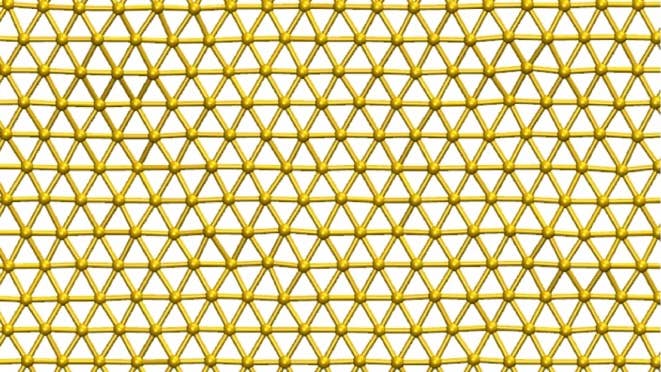Scientists Create Atomically Thin Gold With Century-Old Japanese Knife Making Technique

Share
Graphene has been hailed as a wonder material, but it also set off a rush to find other promising atomically thin materials. Now researchers have managed to create a 2D version of gold they call "goldene," which could have a host of applications in chemistry.
Scientists had speculated about the possibility of creating layers of carbon just a single atom thick for many decades. But it wasn’t until 2004 that a team from the University of Manchester in the UK first produced graphene sheets using the remarkably simple technique of peeling them off a lump of graphite with common sticky tape.
The resulting material’s high strength, high conductivity, and unusual optical properties set off a stampede to find applications for it. But it also spurred researchers to investigate what kinds of exotic capabilities other ultra-thin materials could have.
Gold is one material scientists have long been eager to make as thin as graphene, but so far, efforts have been in vain. Now though, researchers from Linköping University in Sweden have borrowed from an old Japanese forging technique to create ultra-thin flakes of what they’re calling “goldene.”
“If you make a material extremely thin, something extraordinary happens,” Shun Kashiwaya, who led the research, said in a press release. “The same thing happens with gold.”
Making goldene has proven tough in the past because its atoms tend to clump together. So, even if you can create a 2D sheet of gold atoms they quickly roll up to create nanoparticles instead.
The researchers got around this by taking a ceramic called titanium silicon carbide, which features ultra-thin layers of silicon between layers of titanium carbide, and coating it with gold. They then heated it in a furnace, which caused the gold to diffuse into the material and replace the silicon layers in a process known as intercalation.
This created atomically thin layers of gold embedded in the ceramic. To get it out, they had to borrow a century-old technique developed by Japanese knife makers. They used a chemical formulation known as Murakami’s reagent, which etches away carbon residue, to slowly reveal the gold sheets.
Be Part of the Future
Sign up to receive top stories about groundbreaking technologies and visionary thinkers from SingularityHub.


The researchers had to experiment with different concentrations of the reagent and various etching times. They also had to add a detergent-like chemical called a surfactant that protected the gold sheets from the etching liquid and prevented them from curling up. The gold flakes could then be sieved out of the solution to be examined more closely.
In a paper in Nature Synthesis, the researchers describe how they used an electron microscope to confirm that the gold layers were indeed just one atom thick. They also showed that the goldene flakes were semiconductors.
It’s not the first time someone has claimed to have created goldene, notes Nature. But previous attempts have involved creating the ultra-thin sheets sandwiched between other materials, and the Linköping team say their effort is the first to create a “free-standing 2D metal.”
The material could have a range of use cases, the researchers say. Gold nanoparticles already show promise as catalysts that can turn plastic waste and biomass into valuable materials, they note in their paper, and they have properties that could prove useful for energy harvesting, creating photonic devices, or even splitting water to create hydrogen fuel.
It will take work to tweak the synthesis method so it can produce commercially useful amounts of the material, a challenge that has delayed the full arrival of graphene as a widely used product too. But the team is also investigating whether similar approaches can be applied to other useful catalytic metals. Graphene might not be the only wonder material in town for long.
Image Credit: Nature Synthesis (CC BY 4.0)
Related Articles

Refreshing the Brain’s Immune Cells Could Treat a Host of Diseases

Time Doesn’t Really Flow—Your Brain Just Makes You Think It Does

How Will the Universe End? The Dark Eternity That Awaits Us Trillions of Years From Now
What we’re reading
